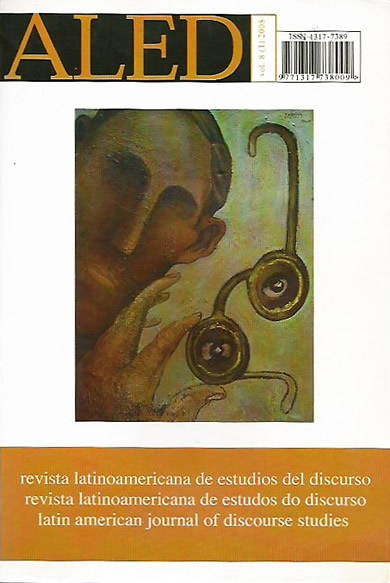Reflexões sobre as noções de leitor, autor e polifonia no hipertexto
Keywords:
hypertext. author. reader. polyphony. plurivocality.Abstract
The discourse analysts can give a relevant contribution to the reflection of questions raised by thinkers in other areas regarding the hypertext. In this article, from the discussion of these authors I discuss the notions of polyphony, reader, and author in the hypertext. I initially present a theoretical framework in which I situate the standpoint from which the hypertext will be analysed. Following from that, studies and discussions surrounding hypertext, reader, and author are raised in order to discuss these positions.
Downloads
References
AUTHIER-REVUZ, J. (1995). Ces mots qui ne vont pas de soi - boucles reflexives etnon-coïncidences du dire. Paris: Larousse.
BAKHTIN, M. (1993). Questões de Estética e de Literatura. São Paulo: UNESP /Hucitec, 3a ed.
BAKHTIN, M. (1997a). Estética da criação verbal. São Paulo: Martins Fontes, 2ªed.
BAKHTIN, M. (1997b). Problemas da poética de Dostoïevski. Rio de Janeiro: Foren-se- Universitária, 2ª. ed.
BAKHTIN, M. / VOLOCHINOV, V. N. ([1929] 1995). Marxismo e Filosofia da Lin-guagem. São Paulo: Ed. Hucitec, 7a ed.
BRAIT, B. (2006) (org.). Bakhtin ”“ outros conceitos-chave. São Paulo : Contexto.
CUNHA, D. A. C. (1992). Discours rapporté et circulation de la parole. Leuven/Louvain-la-Neuve: Peeters/Louvain-la-Neuve.
CUNHA, D. A. C. ([2005] 2006). ‘Dialogismo em Bakhtin e Iakubinskii’, Inves-tigações. Lingüística e Teoria Literária. 18 (2): 103-114.
ECO, U. (1985). Lector in fabula. Paris: Grasset.
FRANÇOIS, F. (1993). Pratiques de l’oral. Paris: Nathan.
FOUCAULT, M. (1969). ‘O que é um autor?’, Boletim da Sociedade Francesa defilosofia: seção do dia 22/02/1969.
FOUCAULT, M. (1971). L’ordre du discours. Paris: Gallimard.
KYHENG, R. M. (2003). ‘Aux origines du príncipe dialogique: l’étude de Jaku-binskij: uneprésentation critique’. Edition éléctronique. http://www.revue-texto.net/Inedits/Kyheng/Kyheng_Jakubinskij.html
LÉVY, P. (1996). O que é virtual? São Paulo: Editora 34.
LÉVY, P. (1993). As tecnologias da inteligência”“ o futuro do pensamento na era dainformática. São Paulo: Editora 34.
MARCUSCHI, L.A. (1999). ‘Linearização, cognição, referência: o desafio do hiper-texto’, Línguas e Instrumentos Lingüísticos, 3: 21-46. Campinas.
MARCUSCHI, L.A. (2000). ‘Gêneros textuais: o que são e como se constituem’.Recife (mimeo).
MARCUSCHI, L.A. (2001). ‘O hipertexto como um novo espaço de escrita em salade aula’, Linguagem & Ensino, 4 (1): 79-112. Pelotas
Downloads
Published
How to Cite
Issue
Section
License

This work is licensed under a Creative Commons Attribution-NonCommercial-NoDerivatives 4.0 International License.
The authors retain the copyright and guarantee RALED the right to be the first publication of the work as well as a Creative Commons Attribution License that allows others to share the work with recognition of authorship and the initial publication in this journal.




